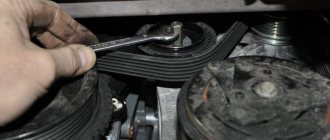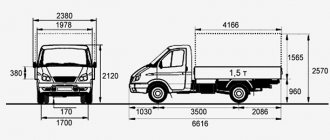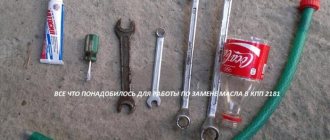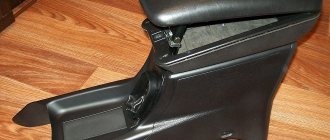Soundproofing Vesta with your own hands is a long process, but its quality can be higher. The factory sound insulation of the Lada Vesta differs from that installed on previous VAZ models - in previous models, drivers did everything with their own hands to get rid of all kinds of crickets and noise. During a quiet drive around the city, noise insulation suppresses extraneous sounds, creating comfort for the Vesta driver. And only when driving outside the city, where the surface coverage is full of surprises and driving speed increases, it becomes obvious that in this part of the Lada Vesta there is still work to be done. The need for sound insulation is recognized by many car owners who often travel in their cars. You can do this work yourself if you know the basic rules - read the article and find out how to make noise in the hood, floor, doors, arches, trunk and panel!
Sound insulation assessment of Vesta
The running engine of the Lada Vesta creates quite a few loud sounds that disturb the driver. Standard noise insulation is not enough to completely cope with them. And yet, experts, having conducted a series of tests, comparing Vesta with other similar sedans, gave an average rating, noting that the acoustic and vibration comfort of Vesta is even higher than that of Volkswagen Polo and Renault Logan. Owners notice that the soundproofing and soundproofing qualities of the car have shortcomings. The reasons for the problems are associated with two features of the car: the absence of rear fender liners, poor door and glass seals. Sound insulation improvements are made taking these factors into account.
Objective measurements of the sound insulation properties of the Lada Vesta showed:
— At a speed of 60 km/h in a car not equipped with rear fender liners, the noise level in the cabin is 64.3 dB versus 63.5 dB for a car with wheel liners.
— At a speed of 90 km/h the indicators increase to 67.1 dB, 65.5 dB.
— At a speed of 110 km/h – 68.9 dB versus 67.5 dB.
Based on the results, we note that installing rear fender liners improves the quality of noise and vibration comfort for passengers/driver.
In addition to the fender liners, owners also modify the roof, trunk, floor, doors, hood, and front panel. The result is a quiet car in which you can travel long distances.
↑ Sound insulation assessment
For several years now, AvtoVAZ has been delighting with its new products, which, according to the automaker, can compete with foreign models in the same price segment in terms of noise insulation characteristics. The sound insulation of the Lada Vesta is a clear example of this approach. But how do drivers evaluate the audibility characteristics of extraneous sounds?
Judging by numerous test drives and online discussions, most owners of the new Lada believe that its sound insulation meets expectations. Measurements carried out by specialists showed that Vesta is even quieter than models such as the Nissan Almera. In particular, at speeds of 60 and 100 km/h, the AvtoVAZ model showed the following noise levels:
- 66.7 dB;
- 68.7 dB.
While cars from a Japanese manufacturer:
- 68.6 dB;
- 70.8 dB.
The domestic car turned out to be quieter in comparison with such a popular model as Logan. At the same time, it was surpassed in terms of performance by Kia Rio and Ford Fiesta.
Most drivers agree that the most problematic element is the wheel arches, due to which this vehicle is particularly noisy on the highway.
But not all consumers find Vesta’s noise level comfortable, so the service to enhance sound insulation is quite popular. Fortunately, it is not particularly expensive.
General procedure
There is a single procedure for improving insulation with your own hands. The standard algorithm includes a number of steps:
First you need to remove the factory trim - gaining access to the metal. Next, the metal is thoroughly degreased. Soundproofing materials are cut to size. Vibration absorber/sound absorber are installed alternately. Then the anti-creak is installed. The trim is assembled in the car. At some stages, vibration-proofing materials are heated with a construction hairdryer and rolled with a roller so that there are no irregularities or bubbles left.
Soundproofing of the Lada Vesta is complete.
The car has become truly more comfortable. Both the driver and passengers will be able to appreciate this. Noise insulation at medium and high speeds has changed dramatically, for the better. The car's microclimate has stabilized. The interior will not cool down so quickly in winter and will not heat up so quickly in summer. The sound of the standard audio system has been improved. The outer metal of the doors has become less susceptible to dents from small impacts (it is precisely such impacts from opening the doors of neighboring cars in the parking lot that lead to dents). And so that you can see what a great and meticulous work we have done, we will provide a full photo report.
Roof sound insulation
To soundproof this part of the car, it is necessary to carry out work on the roof metal. First you will need to unscrew all the ceiling handles, remove the lampshades and stands. This will allow you to easily remove the soft covering and gain access to the metal part of the roof. Next, you will need to lay a vibration and noise absorber on the surface. It is better to use sufficiently dense materials that can cope with the sound wave created under the skin. After installing the insulation, you can install the sheathing/parts in reverse order.
Soundproofing arches
To soundproof the arches on the Lada Vesta, you will need to remove all the wheels and lockers. This part of the car gets seriously dirty, so before degreasing it is necessary to thoroughly clean the arch surface. Further work occurs according to the standard algorithm.
It is better to choose a vibration absorber based on bitumen. The process of gluing the outside of wheel arches is labor-intensive. To make the task somewhat easier, you can cut the materials into small pieces, placing them on the surface one after another. The joints formed during the process are coated with rubber-bitumen mastic. An additional layer of noise insulation is then glued to the locker.
↑ Wheel arches
As noted above, wheel arches are considered the noisiest element of the Lada Vesta design. Therefore, when installing additional sound insulation, they often concentrate on eliminating this shortcoming.
Here the work begins with the removal of the wheels and lockers. All working surfaces are cleaned of dirt and then degreased.
Vibration insulation on a bitumen basis is cut into pieces and glued in this form. It is important to coat all joints well with special mastic. The best material is made from bitumen. The same rubber-bitumen mastic is used to treat all insulation to complete the work. Lockers also need to be insulated.
Soundproofing the floor of Lada Vesta
The work begins with removing all seats, carpets, and upholstery from the interior. As soon as the metal layer becomes accessible, further actions are carried out. To soundproof the floor, use 3 layers of materials:
High quality vibration absorber. It is recommended to purchase premium material for the best insulation. Sound absorber with a thickness of at least 8 mm. NoiseBlock soundproofer. This design will protect the car from external noise over a wide range. As a result, the interior becomes significantly quieter.
The need for sound insulation in Lada Vesta
Sound insulation improves the cabin environment, especially on long trips. Certified, which is the official supplier of AvtoVAZ soundproofing materials, conducted a study. The object was a new Lada Vesta car before and after noise insulation tuning. Testing was carried out at speeds of 60, 80 and 10 km/h. The test results at a speed limit of 60 km/h are presented in Figure 1.
Fig. 1 Noise level in the cabin of the Lada Vesta when driving at a speed of 60 km/h.
Sound insulation properties improved by an average of 1.5 decibels, which is approximately 2%. For comparison, the quiet rustling of leaves creates noise of about 10 decibels, and the ticking of a clock – 25 decibels. The use of modern soundproofing materials creates more comfortable conditions in the cabin, reduces noise from heavy rain, engine roar, etc.
Soundproofing the hood of Lada Vesta
There are several features associated with hood sound insulation. There is an engine located here, which makes a lot of noise and also requires special thermal insulation qualities. Light vibration-proofing materials show the greatest effect during work.
The work itself is carried out only on metal surfaces under the hood. They are thoroughly cleaned of oil and dirt, and then, following the standard algorithm, sound insulation is installed. The work requires skills and patience, so it is ordered from craftsmen to complete it.
Soundproofing Lada Vesta price
I left this point at the very end of the article for a reason. You've probably noticed that high-quality sound insulation of the Lada Vesta requires a lot of materials. So it can't be cheap. And if you do not decide to do everything yourself, then you will also have to add the cost of the work, which in different regions and companies can vary from 10 to 30 thousand rubles, depending on the company.
That's all. Now you can enjoy silence in your car! Thank you for your attention and see you again on our website!
Sound insulation panel
The front panel is insulated to rid the car interior of squeaks and rattles coming from under it. The work is carried out differently, depending on which part the extraneous sounds are heard from. During modification, an anti-creak and vibration absorber are used.
To disassemble the front panel, you need to unscrew the screws and carefully pull it out of the latches located on the side. You need to remove it carefully, not forgetting to disconnect the cable. Next, the panel can be glued with Madeleine or another anti-creaking agent.
Soundproofing process for Lada Vesta
We start by completely disassembling the interior of the car. We remove the door and trunk trim, remove the seats, and remove the factory carpet and headliner. In some cases, you will need to remove the front panel to soundproof the engine shield. But, unfortunately, due to the large amount of work, not everyone dares to do this.
When everything is disassembled, everything needs to be washed, dried and degreased. There is one more question: “Should I remove the factory vibration insulation or not?” There is no definite answer, since there is no such thing as too much sound insulation. But in the case of AvtoVAZ, it is best to remove the factory vibration insulation, since it is not always well glued and can come off over time.
Average price for noise protection
The cost consists of the price of materials/work of the craftsman. When you contact a car repair shop, where they will completely insulate the noise of the car, you will spend on average up to 40 thousand rubles. Independent work will require almost half the investment. True, the work will take about five days or more. Some stores sell ready-made sets of materials and tools for work, the purchase of which will completely reduce expenses to 10 thousand rubles. True, in this case it will not be possible to choose better manufacturers, but this option may be suitable for unassuming car enthusiasts.
Soundproofing the floor and trunk of Lada Vesta
This requires the efforts of every specialist in our well-coordinated team - first we will remove everything unnecessary from the salon in order to create the highest quality working conditions. The underbody is a huge source of noise, but we are doing everything to correct the situation - Comfort mat Dark and Extreme vibration isolators are premium, impeccable solutions.
Our specialists place it wherever they can get their hands - we always strive to show our maximum. Extreme is truly unique - we get the material directly from the manufacturer, with whom we have been cooperating for a very long time.
For the fenders in the trunk we take Comfort mat Dark D3 - no, this is not an attempt to save money, we don’t do that, it’s just that otherwise we won’t be able to assemble the interior properly. Next, we combine different thicknesses of Comfort mat Felton 10 mm - this noise absorber has an impeccable reputation from previous orders. After this, a dense layer of Blocker membrane follows. This soundproofing membrane has a huge number of advantages - we always use it to achieve maximum performance.











